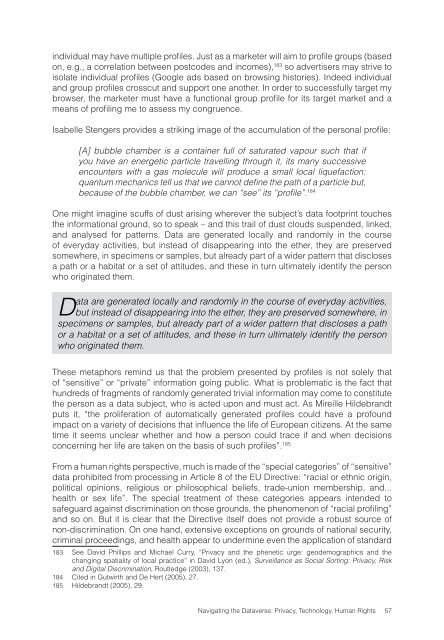Navigating the Dataverse: Privacy, Technology ... - The ICHRP
Navigating the Dataverse: Privacy, Technology ... - The ICHRP
Navigating the Dataverse: Privacy, Technology ... - The ICHRP
You also want an ePaper? Increase the reach of your titles
YUMPU automatically turns print PDFs into web optimized ePapers that Google loves.
individual may have multiple profiles. Just as a marketer will aim to profile groups (based<br />
on, e.g., a correlation between postcodes and incomes), 183 so advertisers may strive to<br />
isolate individual profiles (Google ads based on browsing histories). Indeed individual<br />
and group profiles crosscut and support one ano<strong>the</strong>r. In order to successfully target my<br />
browser, <strong>the</strong> marketer must have a functional group profile for its target market and a<br />
means of profiling me to assess my congruence.<br />
Isabelle Stengers provides a striking image of <strong>the</strong> accumulation of <strong>the</strong> personal profile:<br />
[A] bubble chamber is a container full of saturated vapour such that if<br />
you have an energetic particle travelling through it, its many successive<br />
encounters with a gas molecule will produce a small local liquefaction:<br />
quantum mechanics tell us that we cannot define <strong>the</strong> path of a particle but,<br />
because of <strong>the</strong> bubble chamber, we can “see” its “profile”. 184<br />
One might imagine scuffs of dust arising wherever <strong>the</strong> subject’s data footprint touches<br />
<strong>the</strong> informational ground, so to speak – and this trail of dust clouds suspended, linked,<br />
and analysed for patterns. Data are generated locally and randomly in <strong>the</strong> course<br />
of everyday activities, but instead of disappearing into <strong>the</strong> e<strong>the</strong>r, <strong>the</strong>y are preserved<br />
somewhere, in specimens or samples, but already part of a wider pattern that discloses<br />
a path or a habitat or a set of attitudes, and <strong>the</strong>se in turn ultimately identify <strong>the</strong> person<br />
who originated <strong>the</strong>m.<br />
Data are generated locally and randomly in <strong>the</strong> course of everyday activities,<br />
but instead of disappearing into <strong>the</strong> e<strong>the</strong>r, <strong>the</strong>y are preserved somewhere, in<br />
specimens or samples, but already part of a wider pattern that discloses a path<br />
or a habitat or a set of attitudes, and <strong>the</strong>se in turn ultimately identify <strong>the</strong> person<br />
who originated <strong>the</strong>m.<br />
<strong>The</strong>se metaphors remind us that <strong>the</strong> problem presented by profiles is not solely that<br />
of “sensitive” or “private” information going public. What is problematic is <strong>the</strong> fact that<br />
hundreds of fragments of randomly generated trivial information may come to constitute<br />
<strong>the</strong> person as a data subject, who is acted upon and must act. As Mireille Hildebrandt<br />
puts it, “<strong>the</strong> proliferation of automatically generated profiles could have a profound<br />
impact on a variety of decisions that influence <strong>the</strong> life of European citizens. At <strong>the</strong> same<br />
time it seems unclear whe<strong>the</strong>r and how a person could trace if and when decisions<br />
concerning her life are taken on <strong>the</strong> basis of such profiles”. 185<br />
From a human rights perspective, much is made of <strong>the</strong> “special categories” of “sensitive”<br />
data prohibited from processing in Article 8 of <strong>the</strong> EU Directive: “racial or ethnic origin,<br />
political opinions, religious or philosophical beliefs, trade-union membership, and...<br />
health or sex life”. <strong>The</strong> special treatment of <strong>the</strong>se categories appears intended to<br />
safeguard against discrimination on those grounds, <strong>the</strong> phenomenon of “racial profiling”<br />
and so on. But it is clear that <strong>the</strong> Directive itself does not provide a robust source of<br />
non-discrimination. On one hand, extensive exceptions on grounds of national security,<br />
criminal proceedings, and health appear to undermine even <strong>the</strong> application of standard<br />
183 See David Phillips and Michael Curry, “<strong>Privacy</strong> and <strong>the</strong> phenetic urge: geodemographics and <strong>the</strong><br />
changing spatiality of local practice” in David Lyon (ed.), Surveillance as Social Sorting: <strong>Privacy</strong>, Risk<br />
and Digital Discrimination, Routledge (2003), 137.<br />
184 Cited in Gutwirth and De Hert (2005), 27.<br />
185 Hildebrandt (2005), 29.<br />
<strong>Navigating</strong> <strong>the</strong> <strong>Dataverse</strong>: <strong>Privacy</strong>, <strong>Technology</strong>, Human Rights 57
















